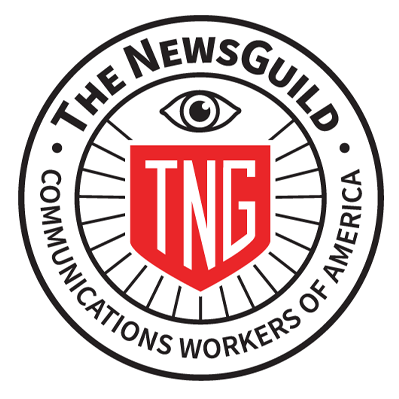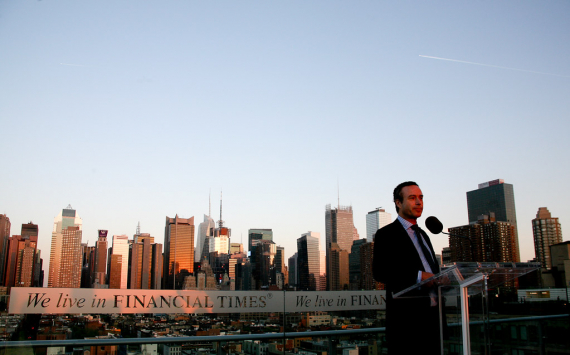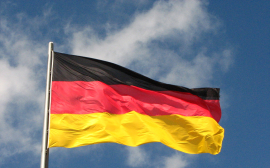Description
The NewsGuild-CWA is a labor union founded by newspaper journalists in 1933. In addition to improving wages and working conditions, its constitution says its purpose is to fight for honesty in journalism and the news industry's business practices. The NewsGuild-CWA now represents workers in a wide range of roles including editorial, technology, advertising, and others at newspapers, online publications, magazines, news services, and in broadcast. The current president is Jon Schleuss.
History
The organization's founders were Joseph Cookman an editor of the New York Post, Allen Raymond of the New York Herald Tribune and Heywood Broun of the New York World-Telegram. The inaugural chapter was based in Cleveland, Ohio, and Carl Randau was its first director from 1934 to 1940. It was originally called the American Newspaper Guild, but it simplified its name to Newspaper Guild in the 1970s to reflect the fact that it also operated outside the United States. It had expanded into Canada in the 1950s.
It became affiliated with the American Federation of Labor in 1936, then left to go into the new Congress of Industrial Organizations in 1937, when it expanded its membership to non-editorial departments. It merged with the Communications Workers of America in 1995. The Guild is also affiliated with the International Federation of Journalists.
The Guild has more than 25,000 members in the United States, Canada and Puerto Rico. Its membership has expanded from just journalists to many other employees of newspapers and news agencies, such as clerks who take classified ads and computer support workers. It also represents workers in a number of other industries.
In 2015, the union changed its name from Newspaper Guild to its current name, NewsGuild, to reflect that newspapers are not the only publishers of news.
In 2021, the union changed its logo to reincorporate an eye motif from the original logos back to the union's founding and to modernize the look of the union for the future.
Broun's influence
The Newspaper Guild, represented by many journalists and other written media workers since 1933, became one of the most continuous and effective media organizations in the United States. Heywood Broun was one of the most respected journalist and most popular, highly paid contributor. On August 7, 1933, Broun acknowledged the New York World-Telegram column and the progress of the newspaper's business which was successful. He evaluated the progress more closely with his bosses than any other colleague of similar economic standing. Broun wrote, "the fact that newspaper editors and owners are genial folk should hardly stand in the way of organization of a newspaper writers' union. There should be always one." His column has influenced journalists from many states to rise up in opposition to the newspaper's authorities and organize by publishers to show the importance of the newspaper union and expanding the foundation.
Heywood launched the Guild during the Depression according to the biography which Richard O'Connor said, "newspapermen to take a more practical view of their working conditions and organize against the rapacity of publishers". During the earlier times of the Guild, there were complaints from the "rapacious" publishers about federal regulation of minimum wages and maximum hours for newsroom workers set by the National Recovery Act. The publishers wanted an amount of money to not pay tax on from the NRA on constitutional grounds and their First Amendment rights would be prohibited if the workers were forced to restrictive management under the government as the forty-hour work week. This rallied around from Broun's call for labor union and one would speak for all newsmen and newswomen.
Status in 1942
In 1942 Henning Heldt, as a Nieman Fellow, contributed an article on the Newspaper Guild to a collection published by Nieman Fellows that year at Harvard University.
In 1934 a convention of the Guild was held in St. Paul, Minnesota. In an effort to elevate the standards of journalism, it was resolved:
That the American Newspaper Guild strive tirelessly for integrity of news columns and the opportunity for its members to discharge their social responsibility: not stopping until the men and women who write, graphically portray or edit news have achieved freedom of conscience to report faithfully, when they occur – and refuse by distortion and suppression to create – political, economic, industrial and military wars.[14]: 80
Heldt described the radical past, arrival, and conservative turn of the Guild in 1942:
The Guild's radical strength is in the New York unit. Estimated at but one-tenth of the total membership of that unit, the radical element has been able to constitute a majority in the past at most meetings by being able to command full attendance of its group. Control of the New York unit with its large membership and voting power at national conventions, equal to one-fifth of the whole Guild, gave this element a disproportionate influence.
The Guild has established itself as a fixture in the American newspaper scene. The early period of mushrooming growth has come to an end. But the number of locals, of dues-paid members, and of signed contracts continues to grow.
Militant and leftist in both policies and politics during its formative years, the Guild has now swung abruptly to the right, following a national referendum last fall. A conservative slate of officers was elected on a platform promising strict attention to economic activities of the Guild, strict avoidance of any radical political action.
Positing a "legend of newsmen", Heldt lamented that the Guild finished off the legend:
The coming of the Guild has destroyed, however, the romantic legend of the profession of journalism. Gone forever are the days when the newspaperman himself, as well as the public, considered his work as something unique, a shining adventure and somewhat sanctified calling, not to be measured in terms of dollar-and-cent rewards. Newspapermen now realize their place in the economic picture. They know themselves to be skilled white-collar workers and have adopted the methods of other skilled groups to improve their economic status.
In 1970s, the union expanded its scope outside of the United States. and adopted the name of Newspaper Guild or TNG. It also collaborated with another union called the Communications Workers of America (CWA) in 1977. The combined union had hundreds of thousands of workers in telecommunications and media, and later adopted a new name, The Newspaper Guild-CWA.























